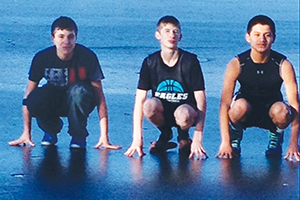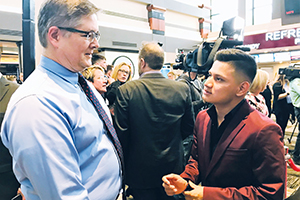Lifeless for 45 minutes
By ELLEN FUTTERMAN
The faith-based feature film Breakthrough, now playing in theaters, tells the real-life story of John Smith, a 14-year-old who fell through the ice at a St. Charles, Mo.-area lake in January 2015, was deprived of oxygen for more than 15 minutes and had no pulse for nearly an hour. Despite enormous odds, the teen went on to make a full recovery in less than a month, after his mother turned to her faith and prayed over his body.

Dr. Jeremy Garrett, a SLUCare intensivist who cared for Smith at SSM Health Cardinal Glennon Children's Hospital in St. Louis, calls his recovery "a bona fide miracle." But, he adds, "looking at the whole thing in retrospect, it really was more like several miracles." SLUCare is the academic medical practice of Saint Louis University.
"I have been a doctor in pediatric critical care for 30 years," said Garrett, "and I have seen some miracles in that time but this one is wholly unique."
The first miracle, says Garrett, took place as soon as first responders arrived at Lake Sainte Louise in Lake Saint Louis, where Smith and two friends, both named Josh, had fallen through the ice into 40-degree water. Both Joshes were quickly rescued, but Smith remained submerged for much longer, until one of the first responders thought he heard his captain say to search the area again.
"As it turns out, the captain says he didn't say anything," recalls Garrett. "But (first responder) Tommy Shine said a voice told him to go back and check the area that he had already checked. And that's when he found John's body."
Garrett notes what also helped was the fact that these first responders in the suburban St. Louis community had a week earlier completed cold-water rescue training in Iowa. That the water was so cold may have actually helped keep Smith's brain intact.
The second miracle, Garrett continues, occurred after Smith was rushed to SSM Health St. Joseph Hospital - Lake Saint Louis, where Dr. Kent Sutterer and his emergency room team worked to get Smith's pulse back. After 45 minutes and nothing, even after eight doses of epinephrine, doctors knew Smith's chances of regaining a heartbeat were virtually nil, so they waited until his mother arrived to break the devastating news. But Joyce Smith was having no part of it. Instead, she prayed over her son and commanded the Holy Spirit to restart Smith's heart. Within minutes, the boy's heart started to beat again.

"That was so profound that Dr. Sutterer did write down his thoughts on the matter later that evening because he had never witnessed anything like that," says Garrett. "I've never met another physician who witnessed something like that."
Smith was then airlifted to Cardinal Glennon, where he came under the care of Garrett, a nationally recognized expert on treating drowning and hypothermia patients.
"John's heart was beating but he was not breathing in any way that would sustain life," says Garrett. "I examined him briefly as he arrived. I was confirming what I was afraid of — he didn't have neurologic function yet. ... I talked to the family and let them know even though his heart had been restarted, the question of him being able to be kept alive is in serious doubt. It was very worrisome that his brain may not survive and that he would be brain dead, or, if that didn't happen, he would be severely neurologically impaired."
Garrett says a "distinct pause followed" before Joyce Smith flatly said he was wrong. "She told me I didn't know her son. She knew he was a fighter and he was going to make it through this. They would take care of praying and if I were any good at being a doctor, I needed to get back out there and do my job."
As the night progressed into the next day, Smith seemed to show some movement in his arms. Eventually Garrett was called in to assess Smith, at which time he performed a high-level neurological function exam tailored just for Smith, who is a huge basketball fan. The doctor asked Smith to answer questions about his favorite players, Michael Jordan and LeBron James, by raising either his right or left hand. Not only did Smith answer all of the questions correctly, he also procured Garrett's favorite Michael Jordan tie by doing so.

Garrett says while there may be a medical explanation as to what happened — that Smith's brain and body got cold before he was deprived of oxygen and his heart and circulation stopped — he still believes the teen's complete recovery qualifies as a true miracle. "Cardinal Glennon is a place where faith is valued," he said. "Faith does make a difference. I just wish I could get it to work all the time."
Garrett believes the movie did a good job depicting the circumstances surrounding Smith's ordeal, though some liberties were taken to make the narrative more suspenseful and dramatic.
As for the actor, Dennis Haysbert, who played Garrett in Breakthrough, the doctor says he was "honored by the portrayal." Haysbert, who has appeared in numerous films, is familiar to many for his Allstate insurance commercials.
"Overall, I liked the movie," says Garrett, adding that he is not getting any money from the film. "I'm just waiting for the action figures to come out."
